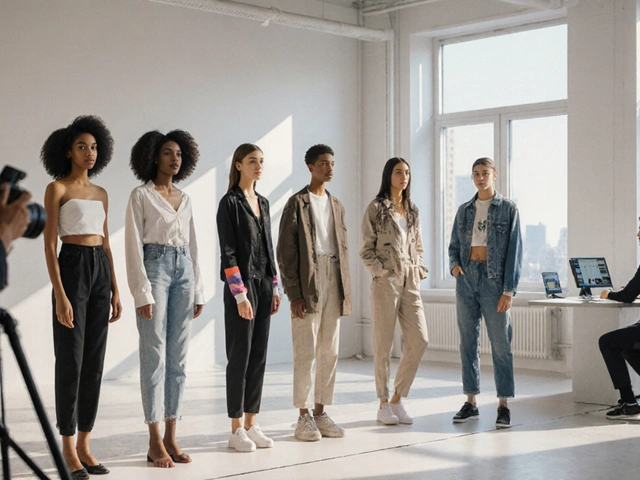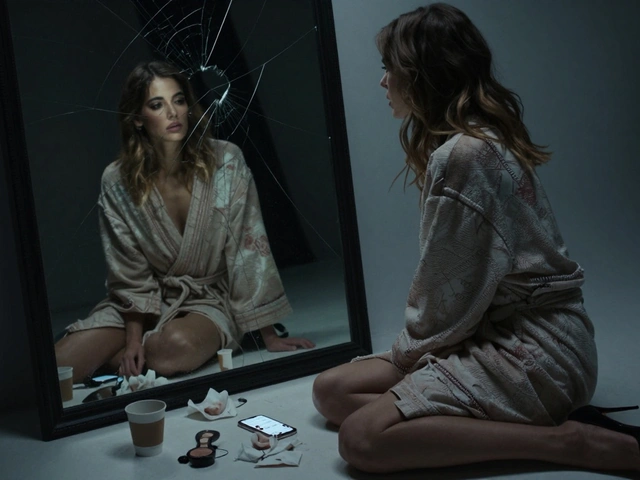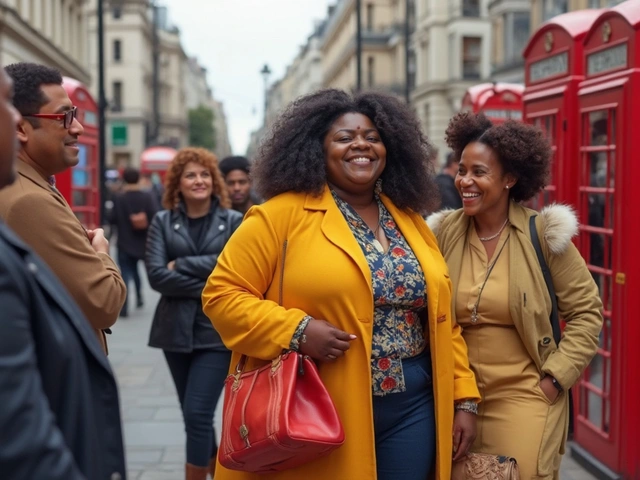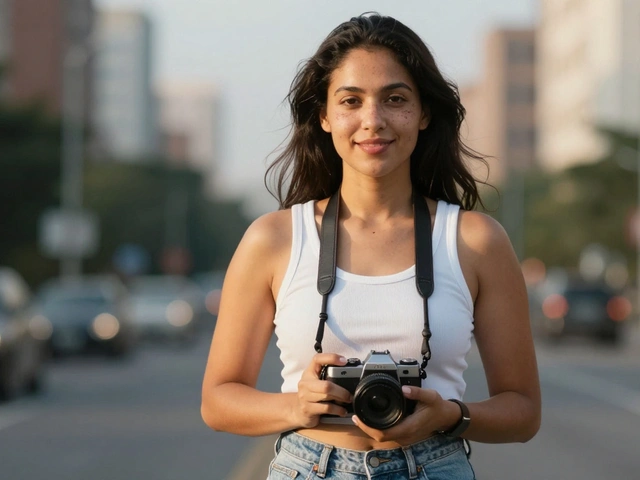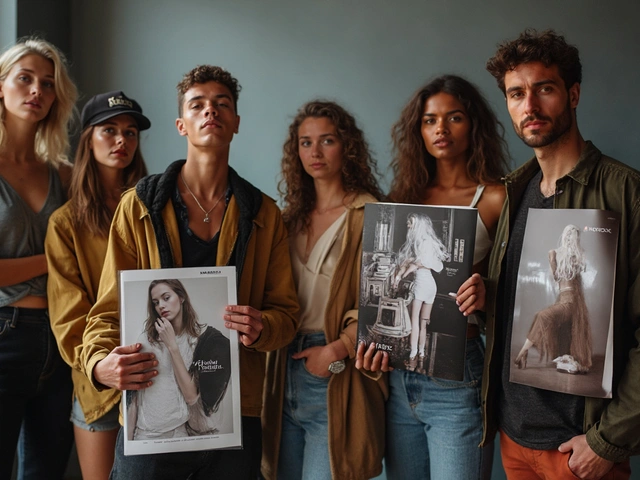There’s no sugarcoating it—a model portfolio is your calling card, and if it doesn’t grab attention, you’ll stay stuck in the waiting room while others snatch gigs. The truth? Agencies and clients rarely give second chances if your book misses the mark.
You might wonder, “What exactly do they want to see?” or “How polished should my images really be?” No one’s expecting you to be a Photoshop pro or to have high-fashion looks in every shot. What matters is showing the real you, with just enough variety to prove you can wear the looks and play the roles.
Start with a tight collection. Forget about including twenty similar selfies—pick five to ten shots that are sharp, professional, and highlight your range. Show a clean headshot, a full-length body photo, and at least one ‘editorial’ feel. Toss out anything your grandma would want on her mantelpiece (unless she runs a modeling agency—then maybe rethink it!).
Stick around for the breakdown of what works, what doesn’t, and how to set yourself up for real opportunities. If you’re ready to give your modeling dreams a solid shot, you’re exactly where you should be.
- Key Takeaways: Model Portfolio Dos & Don'ts
- The Fast Answer: What Makes a Successful Model Portfolio
- Why a Great Portfolio Matters
- What to Include (and What to Skip)
- Finding the Right Photographer and Team
- Tips to Stand Out and Common Mistakes to Avoid
Key Takeaways: Model Portfolio Dos & Don'ts
Building a model portfolio isn’t rocket science, but a few smart moves can get you on the fast track. Here's the stuff that shapes a portfolio agencies actually notice—and the mistakes that will make your stack get tossed.
- Do show range. You want headshots, full-body shots, and at least one fashion-forward or creative look. But keep it to the point—5 to 10 strong images max.
- Don’t mix old, low-quality, or unedited photos. Blurry, dated, or overly filtered images are a red flag for any serious agency.
- Do book with a reputable photographer. Professionals know how to flatter your features, bring out your best sides, and capture the details that matter in modeling work.
- Don’t overload your book with makeup or heavily styled looks. Agencies want to see your real bone structure and natural expression—not just what you look like after a glam squad visit.
- Do update your portfolio as you grow. Outdated images are a sure way to waste everyone’s time.
- Don’t copy someone else’s style shot for shot. Your model portfolio should show what’s unique about you—don’t play it safe and blend in.
- Do use simple backgrounds and clean lighting. Distracting props or odd backdrops take the focus off you (which is the last thing you want).
- Don’t use selfies, group photos, or casual phone snaps. This isn’t your Insta feed—this is your career’s first impression.
| Do | Don't |
|---|---|
| Show clear face and body shots | Add over-edited or filtered photos |
| Work with a pro photographer | Use group party pictures |
| Update your book often | Leave in outdated looks |
| Highlight personal style | Copy someone else’s vibe |
Fun fact: Most agencies spend less than 90 seconds flipping through a model portfolio. You've got to make every shot count. Sticking to these dos and don'ts puts you way ahead of the curve.
The Fast Answer: What Makes a Successful Model Portfolio
If you want your model portfolio to stand out—no matter if you’re just starting or leveling up—here’s what actually works. First, agencies and clients are looking for clarity and personality, not over-the-top editing. Your photos should look like you, just on a really good day. Authenticity always wins.
To nail it, keep these rules in mind:
- Professional photos only. Your phone might take great pictures, but people in the industry can spot a DIY shot from a mile away. Invest in a photographer who knows what agencies want.
- Diverse looks, but not confusing variety. Show your range by including headshots, full-length shots, and a couple of different styles (think casual, a little glam, maybe one sporty)—but keep them consistent enough that it’s clear who you are.
- Keep it tight. Six to ten great images are way better than twenty average ones. Every image in your model portfolio should have a purpose.
- No heavy filters or retouching. Agencies literally want to see you as you actually look. Too much Photoshop is a quick way to the reject pile.
- Simple backgrounds win. Fancy settings aren’t as important as you think. Clean, distraction-free backgrounds put all the focus on you.
If you’re curious about what agencies ask for, the basics usually include:
| Required Shot | Why They Care |
|---|---|
| Headshot (natural look) | Shows your features clearly |
| Full-body shot | Displays proportions and posture |
| Profile shot | Highlights side profile, versatility |
| Editorial/fashion shot | Demonstrates ability to model clothing/styling |
Bottom line: A model portfolio isn’t about showing your best party pic or that heavily filtered selfie from vacation. It’s about sharp, honest shots that show potential. If agencies and clients can imagine you landing different jobs—commercial, fashion, fitness, whatever you want—your portfolio is doing its job.
Why a Great Portfolio Matters
Your model portfolio isn’t just a bunch of pretty pictures—it’s the first thing agents and clients check when deciding whether to book you. This is your “first impression moment,” and let’s be real, in modeling, people do judge the book by its cover. If your portfolio looks random or messy, it sends the message that you’re not serious, or worse, not ready for real jobs.
Agencies get hundreds of submissions every week. Most of the time, they scroll through your shots in under a minute. Within those seconds, your model portfolio needs to clearly show:
- Your look (obviously—headshots, full body, and different angles count here)
- Your versatility (you want to show you can wear casual, glam, fitness, or whatever part of the industry you’re aiming for)
- Your personality (are you fun and approachable, or can you pull off an edgy or high-fashion vibe?)
According to a 2024 survey by the Model Alliance, almost 85% of agencies say they won’t consider a new face if the portfolio isn’t professional. Ready for another eye-opener? Models with a “just okay” portfolio get about 3 callbacks out of 50 submissions, while those with an eye-catching, focused model portfolio get around 17 callbacks.
| Portfolio Quality | Callback Rate |
|---|---|
| Casual/Amateur | 6% |
| Professional & Versatile | 34% |
If you want to get signed or land paid gigs, you need more than a bunch of selfies or random party shots. A strong model portfolio shows you take your modeling career seriously. It proves you’re ready to work with real photographers and deliver what clients want. It’s not about having the same look as everyone else—it’s about showing your unique take, clearly and confidently.
So, don’t think of your portfolio as homework, think of it as your handshake with the industry. Nail it, and you’re way more likely to hear “when can we meet?” instead of “thanks, we’ll call you.”

What to Include (and What to Skip)
Not sure what belongs in your model portfolio? There’s a sweet spot between variety and focus, and hitting it means you’ll get noticed for the right reasons. Let’s get into the specifics.
- Headshot: This is your first impression. Use natural light, wear light makeup (if any), and make sure your hair is out of your face. No crazy filters—just you, the way agencies want to see you.
- Full-Body Shot: Show your proportions. Stand tall, don’t hide your shape under baggy clothes. Keep it simple with minimal posing.
- Editorial/Image with Personality: Something that says, “Here’s what I bring to a shoot.” A shot with a little mood or style or even a bit of attitude goes a long way.
- Commercial Shot: This one should feel like you walked off a TV ad. Natural smile, relaxed pose, nothing too “runway.”
- Range Photo: Show you can morph a bit—try a beauty close-up, fitness, lifestyle, or swimwear, depending on your goals. If you’re not comfortable with certain types, skip them. Comfort reads on camera, always.
Here’s what you want to skip—not because you can’t pull them off, but because they just don’t serve your modeling tips game:
- Selfies and Snapshots: Even your best phone pic isn’t as strong as a pro shot. Leave them on social media.
- Overly Edited Images: If you don’t look like yourself in real life, agents will spot it immediately. One top agency rep said,
“Nothing turns us off faster than when we can’t recognize someone walking in the door from the portfolio they sent us.”
- Group Photos: You don’t want to play Where’s Waldo? with your portfolio. Make it about you. Every frame should feature you and only you.
- Repetitive Poses: Ten versions of the same smile aren’t showing range. Mix it up so agents see your versatility.
- Out-of-Date Photos: Changed your hairstyle or look? Update your book. Agencies expect current shots—old images can even get you dropped.
Agencies look for quality, not quantity. You don’t need more than 10-12 great, diverse shots. Sometimes, less is more—if a photo doesn’t make you look your best, leave it out. Here’s a quick breakdown:
| Photo Type | Must Have? | Notes |
|---|---|---|
| Natural Headshot | Yes | Front page of your book, keep it clean |
| Full Body Shot | Yes | Slim clothes, simple pose |
| Editorial | Preferred | Shows personality or edge |
| Group Photo | No | Just you, no distractions |
| Heavily Edited | No | Stay true to your real look |
When in doubt, show variety, keep it current, and make every shot count. The right mix helps you get noticed by clients hunting for models with adaptability and professionalism.
Finding the Right Photographer and Team
Nailing your model portfolio means you need a solid crew—and the photographer is at the center. Don’t just scroll through Instagram and pick the first person with a nice camera. Look for someone who’s shot actual model portfolios before and gets what agencies want. Not all photographers know how to highlight your best angles or work with natural light. Check their website or portfolio for clean, sharp model images with mix of headshots and full-body shots. Skip anyone whose shots look more like wedding albums or baby photos.
Before you commit, ask around. Models chat, and you can usually find reviews or real-life experiences in local modeling Facebook groups or even on Reddit. A legit photographer won’t be cagey about sharing references or names of people they’ve worked with. Watch out for anyone who’s pushy or doesn’t make contracts clear. If fees are vague or deals seem too good to be true, something’s probably off.
- Look for a photographer who’s familiar with model portfolio work—not just general portraits.
- Ask to see a full portfolio, not just their top three glam shots.
- Make sure their editing style matches what you want—over-retouched pics won’t fly with most modeling agencies.
- Talk about copyright; most pros will let you use your own photos for self-promotion but always check.
The dream team isn’t only the person behind the lens. If you can, hire a hair stylist and makeup artist with experience in fashion or portfolio shoots. Their skills can mean the difference between "What a great shot!” and “Was that taken on your phone?” Many agencies suggest skipping super heavy makeup and going for a look that feels fresh and true to you.
You don’t need to blow your budget, either. A lot of newer photographers are building their own portfolios and may offer a trade-for-print (TFP) deal—meaning you model, they shoot, and both get photos to use. Just make sure the result matches professional standards, and always have everything in writing about who’s paying for what and how photos can be used.
If you’re curious about rates, here’s a rough idea:
| Shoot Type | Average Price (USD) |
|---|---|
| Entry-level photographer | $100 - $250 |
| Experienced/model specialist | $300 - $700 |
| Hair & Makeup Artist | $75 - $200 each |
One last thing—good communication matters. You want to feel comfortable on set, ask questions, and actually enjoy the shoot. A great team makes you look better because you’ll feel more confident. Choose wisely; your model portfolio will thank you for it.
Tips to Stand Out and Common Mistakes to Avoid
If you want your model portfolio to get noticed, you can’t just slap together a bunch of decent photos and call it a day. You need to show range, attitude, and commitment—without making rookie errors that turn off agencies fast.
- Show Versatility: Vary your looks and poses. Include both commercial-style smiles and editorial, more serious expressions. More than 70% of top agencies say they look for versatility, not just one strong look.
- Update Regularly: Don’t roll with the same headshot you used two years ago. Agencies expect to see current images—hair color, style, even tattoos should match real life. Update every 6-12 months if you’re working actively.
- Keep It Professional: Don’t use selfies, party pics, or filtered Instagram shots. Only professional, high-quality images belong in your model portfolio. Get rid of any images with distracting backgrounds or heavy editing.
- Know Your Audience: If you’re going for fashion, your shots should reflect that vibe. A commercial or lifestyle model portfolio looks different than a runway or editorial book. Research what’s getting models signed in your field.
- Natural Shots Are Gold: At least one photo should show you with minimal makeup, simple hair, and clean clothes. This helps agencies see ‘the real you’ and is often the shot they’re most interested in.
- Include a Polaroid or Digitals: Most agencies and casting directors ask for plain, unretouched ‘digitals’—think jeans, a simple tee, and front/side shots. These never go out of style for a reason.
- Show Personality, But Not Drama: Smile, laugh, be expressive, but avoid wild faces, odd angles, or gimmicks. Let your confidence and vibe come through naturally.
Of course, there are some classic mistakes nearly every beginner makes once. Here’s what not to do:
- Over-editing: If your skin looks airbrushed or your waist suspiciously slim, it’s a turnoff. Agencies want to see the real you, flaws included.
- Too Many Similar Shots: Five swimsuit poses in a row? Boring. Aim for variety in your portfolio.
- Forgetting Contact Info: It’s shocking how many new models leave this out. If your email or agent’s info isn’t easy to find, you’ll miss out on callbacks.
- Using the Wrong Photographer: Just because someone owns a camera doesn’t mean they get the business. Find a photographer with experience in model portfolio work.
- Ignoring Feedback: If multiple people (especially industry pros) tell you a photo isn’t working—listen. Don’t be too attached to any one shot.
| Stand Out Tip | Common Mistake |
|---|---|
| Mix commercial & high-fashion looks | Same makeup & style in every photo |
| Show current, accurate appearance | Using old or heavily-edited images |
| Add raw digitals or Polaroids | Relying only on glam shots |
| Keep contact info up front | Contact info missing or hard to find |
Bottom line: the goal isn’t perfection, it’s personality and professionalism. When you nail the basics and show a bit of you in each shot, you’ll give yourself a much better chance at getting noticed—and landing real gigs in the modeling world.

